- Home
- Institut Néel
- Research teams
- Technical Groups & Services
- Work at the Institut
- Partnerships
Since January 2019, the Quantum Electronic Circuits Alps team gathers researchers from the Quantum Coherence (CQ) and the NanoSpin teams. This merger is part of an ambitious effort to build a joint research group together with teams from CEA-IRIG and CEA-LETI in order to face the challenge of the rapidly developing field of Quantum Technologies. The joint research team focuses its research on experimental studies to reveal quantum effects in original and novel quantum nano-electronics devices.
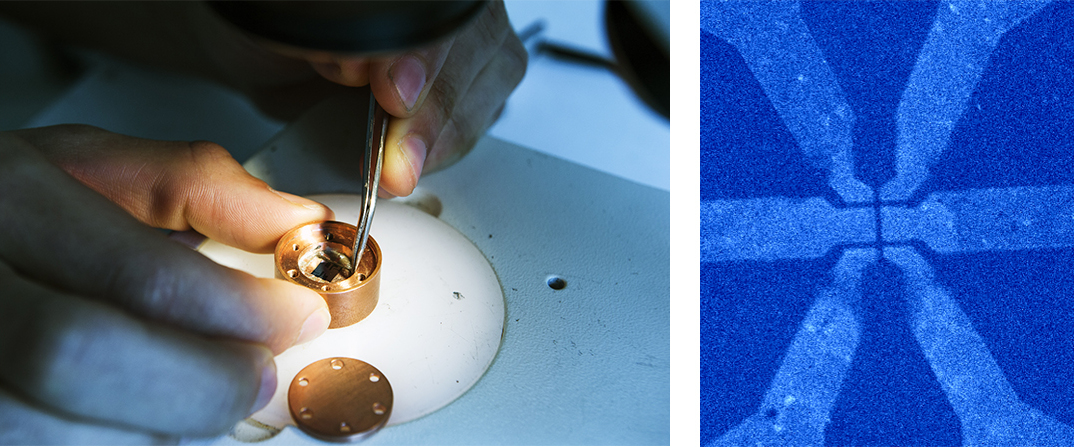
The team members share common research interests and develop original experimental techniques for electronic transport measurements and microwave techniques to observe and control new quantum effects in various different materials. The team’s specificity lies within the quantum nano-electronic circuit itself that defines the novel physics, the material used to build it and the measurement technology. To have access to quantum coherence effects in electronic systems and to their coherent manipulation, very stringent experimental conditions are required such as very low temperature, very low noise and weak measurement signals, microwave techniques as well as high quality nano-fabricated samples.
Original results from the team were obtained also thanks to a continuous effort to develop novel technology (Josephson-junction arrays, scanning probe experiments…) and novel high-quality nanostructures (topological insulators, epitaxially grown superconductors…). During the last 5 years, the team has been strongly involved in building novel experimental set-ups to control multi-qubit systems, to develop quantum-limited amplifiers, to develop opto-electronic techniques compatible with cryogenic environment and to develop cryogenic refrigerators. The team has significantly increased the number of its experimental sites. This was made possible thanks to a strong support of the NEEL technological groups, to grants through funded projects and also to the dynamism and commitment of permanent as well as non permanent researchers.
The QuantECA team focuses its research on experimental studies to reveal quantum effects in original and novel quantum nano-electronics devices. Its research activities can be decomposed into the following main topics:
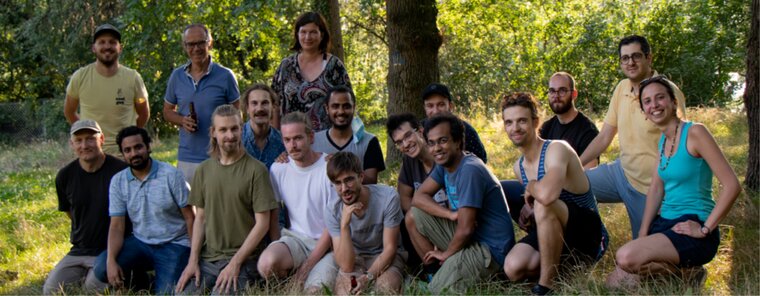
Olivier Buisson, Wiebke Hasch-Guichard, Cécile Naud and Nicolas Roch
Karthik Bharadwaj, Thibault Charpentier, Jovian Delaforce, Martina Esposito, Dorian Fraudet, Sébastien Leger, Vladimir Milchakov, Luca Planat, Kazi Rafsanjani, Arpit Ranadive
During the last decade, it has been demonstrated that superconducting circuits including Josephson junctions behave as quantum bits and are very well suited to realize advanced quantum mechanical experiments. These circuits appear as artificial atoms whose properties are defined by their electronic characteristics (capacitance, inductance and tunnel barrier).
Moreover, given their mesoscopic size, these quantum bits couple very strongly to electromagnetic radiation in the microwave range. Thus, it is now possible to perform quantum optics experiments using microwave photons and to unravel light-matter interactions using circuits.
In our group, we design and build novel superconducting quantum circuits. One aim is to develop the next generation superconducting qubits (with longer coherence time and/or higher read-out fidelity). We are also interested in using these circuits to explore phenomena that challenge the current understanding of quantum mechanics (e.g. quantum phase slips, quantum phase transition or quantum criticality). Finally we investigate the quantum limits of amplification and microwave detection using such superconducting quantum circuits (with a wealth of application in quantum sensing). These advanced experiments rely on nanofabrication, microwave measurement, very low noise electronics and very low temperature techniques. We benefit from the strong support of the technical groups in Néel Institute and from various national and international collaborations.
We are studying non-demolition quantum measurements in a quantum system consisting of a superconducting quantum bit (a “qubit”) coupled to a radiative microwave field which carries the information to a classical detector. In an original experiment, we have developed a new coupling between the qubit and the microwave radiation field, called “cross-Kerr”. The qubit itself is realized by an aluminum superconducting circuit containing two Josephson tunnel junctions of submicron size. Electron-beam lithography was used to create a resin mask employed for defining the microwave circuit during thin-film evaporation of the aluminum. The superconducting properties of the circuit are essential for obtaining a non-dissipative microwave oscillator with quality factor as large as 105. In order that thermally-induced quantum fluctuations do not mix the two quantum states, the experiments must be performed at kBT ≪ ℏωqb. The oscillator is held at the very low temperature of 30 mK in a home-made dilution cryostat.
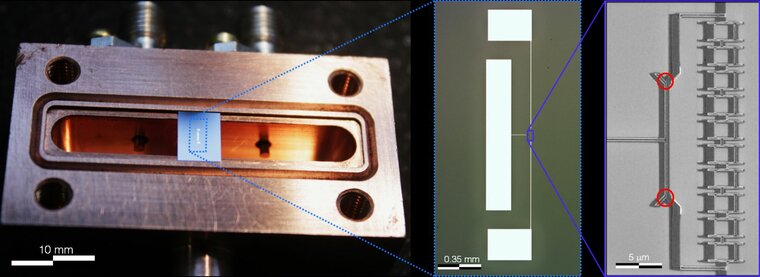
Collaborations: Tomás Ramos and Juan-José García-Ripoll, Quantum Information and Foundations Group, IFF-CSIC, Madrid, Spain.
Publications:
A V-shape superconducting artificial atom based on two inductively coupled transmons, É. Dumur, B. Küng, A. K. Feofanov, T. Weissl, N. Roch, C. Naud, W. Guichard, O. Buisson, arXiv:1501.04892, Phys. Rev. B 92, 020515(R) (2015).
Fast high fidelity quantum non-demolition qubit readout via a non-perturbative cross-Kerr coupling, R. Dassonneville, T. Ramos, V. Milchakov, L. Planat, E. Dumur, F. Foroughi, J. Puertas,S. Leger, K. Bharadwaj, J. Delaforce, C. Naud, W. Hasch-Guichard, J. J. Garcıa-Ripoll, N. Roch, and O. Buisson, Phys. Rev. X 10, 011045 (2020).
Fundings: ANR REQUIEM
We have developed several circuits of the Fluxonium qubit. We are analysing the different loss mechanism in this superconducting qubit depending whether it is measured in a 3D or 2D configuration.

Collaborations:
Gianluca Rastelli, University of Konstanz, Germany
Ioan Pop, Karlsruhe Institute of Technology, Germany
Funding: ERC FreqJoc, COFUND Greque
By making arrays of Josephson junction, we can obtain a new type of metamaterials: high impedance and tunable transmission lines. We are studying the dynamics of these chains of Josephson junctions. Plasma modes propagating along the chains have been experimentally and theoretically analyzed as well as their Kerr nonlinearities. In particular we have studied the dispersion and non-linear self- and cross-Kerr frequency shifts of plasma modes in a one-dimensional Josephson junction chain containing 500 SQUIDs in the regime of weak nonlinearity. In the strong quantum fluctuation regime, we studied the effect of the quantum phase slips.
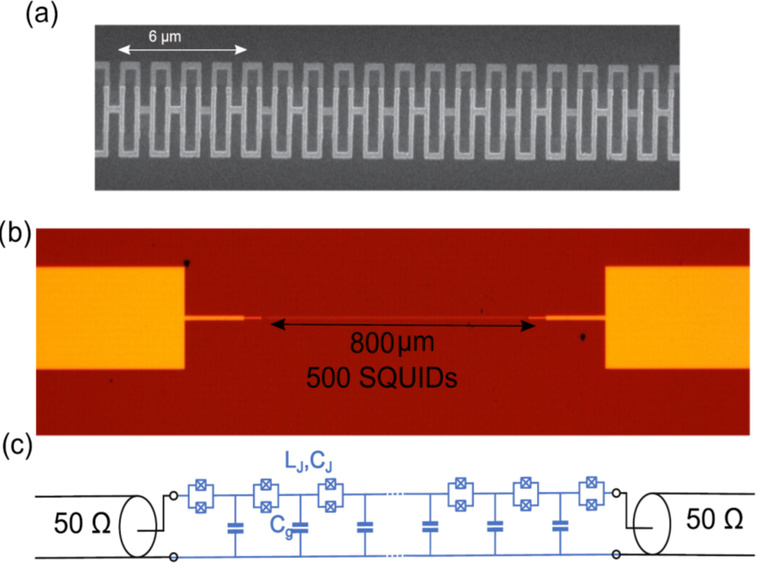
Publications:
Kerr coefficients of plasma resonances in Josephson junction chains, Thomas Weißl, Bruno Küng, Étienne Dumur, Alexey K. Feofanov, Iulian Matei, Cécile Naud, Olivier Buisson, Frank W. J. Hekking, Wiebke Guichard, Phys. Rev. B 92, 104508, (2015).
Kerr nonlinearity in a superconducting Josephson metamaterial. Yu. Krupko, V. D. Nguyen, T. Weissl, E. Dumur, J. Puertas, R. Dassonneville, C. Naud, F. W. J. Hekking, D. Basko, O. Buisson, N. Roch, W. Guichard, Phys. Rev. B 98, 094516 (2018) (2018).
Fundings: ERC FrequJoc
The use of superconducting circuits as building blocks for studying light matter interactions at the fundamental level was introduced more than a decade ago and is named Circuit Quantum ElectroDynamics (circuitQED). With this project we are pushing these ideas to the next level and building circuits to explore many-body quantum optics.
To reach this novel physics, we have developed a unique quantum platform based on superconducting qubits coupled to plasma modes propagating inside an extended Josephson junctions chain. By tailoring the properties of this metamaterial (more specifically its characteristic impedance), we can enhance the qubit-plasma modes coupling up to the ultra-strong coupling regime.
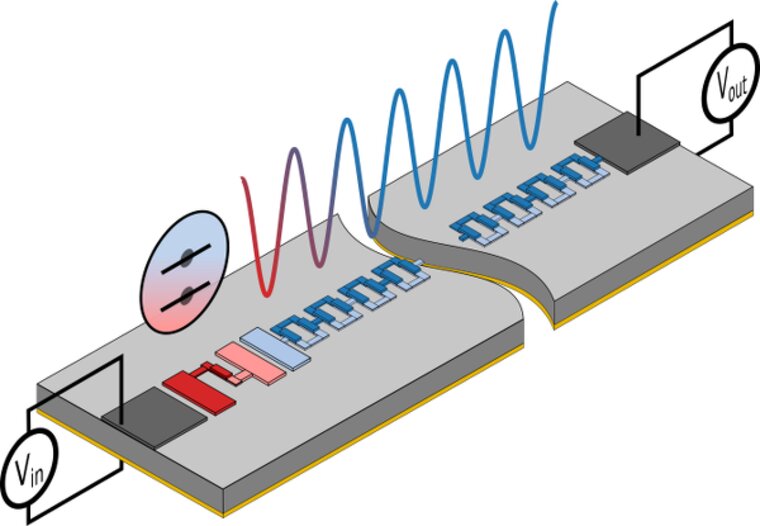
Publications:
Observation of quantum many-body effects due to zero point fluctuations in superconducting circuits, S. Leger, J. Puertas Martínez, K. Bharadwaj, R. Dassonneville, J. Delaforce, F. Foroughi, V. Milchakov, L. Planat, O. Buisson, C. Naud, W. Hasch-Guichard, S. Florens, I. Snyman, and N. Roch, Nature Communications 10, 5259 (2019), Arxiv | Nat. Commun.
A tunable Josephson platform to explore many-body quantum optics in circuit-QED, J. Puertas Martinez, S. Leger, N. Gheereart, R. Dassonneville, L. Planat, F. Foroughi, Y. Krupko, O. Buisson, C. Naud, W. Guichard, S. Florens, I. Snyman, N. Roch, npj Quantum Information 5, 19 (2019), Arxiv | npj Quantum Information
Particle production in a waveguide ultra-strongly coupled to a qubit, N. Gheeraert, X. H. H. Zhang, S. Bera, N. Roch, H. U. Baranger and S. Florens, Physical Review A 98, 43816 (2018), Arxiv | Phys. Rev. A
Fundings: ANR CLOUD, LANEF, ANR BOCA, QuantERA SiUCs
Measuring these microwave photons with very high quantum efficiency remains a tremendous challenge, since the energy conveyed by one single microwave photon is hundreds thousand times smaller than the one of usual optical photons. Yet signals at the single-photon level can be measured using Josephson parametric amplifiers.
In our team we are now using superconducting metamaterials (see figure) to engineer the next generation of parametric amplifiers. These new devices allow us to explore the quantum limits of amplification as well as to perform quantum optics experiments.

Publications:
A photonic crystal Josephson traveling wave parametric amplifier, L. Planat, A. Ranadive, R. Dassonneville, J. Puertas Martínez, S. Leger, C. Naud, O. Buisson, W. Hasch-Guichard, D. M. Basko, and N. Roch, Physical Review X 10, 021021 (2020) Arxiv | Phys. Rev. X. See also Physics Synopis: A Simple Solution for Microwave Amplification and CNRS la lettre innovation: Un amplificateur quantique pour la lecture des bits quantiques.
Non-degenerate parametric amplifiers based on dispersion engineered Josephson junction arrays, P. Winkel, I. Takmakov, D. Rieger, L. Planat, W. Hasch-Guichard, L. Grünhaupt, N. Maleeva, F. Foroughi, F. Henriques, K. Borisov, J. Ferrero, A. V. Ustinov, W. Wernsdorfer, N. Roch, and I. M. Pop, Physical Review Applied 13, 024015 (2020), Arxiv | Phys. Rev. Applied
Fabrication and characterization of aluminum SQUID transmission lines, L. Planat, E. Al-Tavil, J. Puertas Martínez, R. Dassonneville, F. Foroughi, S. Leger, K. Bharadwaj, J. Delaforce, V. Milchakov, C. Naud, O. Buisson, W. Hasch-Guichard, and N. Roch, Physical Review Applied 12, 064017 (2019), Arxiv | Phys. Rev. Applied
Understanding the saturation power of Josephson Parametric Amplifiers made from SQUIDs arrays, L. Planat, R. Dassonneville, J. Puertas Martínez, F. Foroughi, O. Buisson, W. Hasch-Guichard, C. Naud, R. Vijay, K. Murch, and N. Roch, Physical Review Applied 11, 034014 (2019), Arxiv | Phys. Rev. Applied
Fundings: ANR CLOUD, LANEF, ANR BOCA, QuantERA SiUCs
Hybrid superconducting-semiconducting systems are promising candidates for nano-electronic quantum devices including qubits and quantum circuits. In collaboration with the Institute of Solid-State Electronics at TU Wien, Vienna, Austria and IRIG/LEMMA in CEA Grenoble, we have fabricated and characterised hybrid nanowire aluminium/germanium/aluminium heterostructures. A novel annealing technique allows to reach atomically precise interfaces. Measuring at low temperature, we have demonstrated the exceptional electrical transport characteristics of these high-quality nanowires heterostructures. By tuning with a single gate, we observe from single hole quantum dot to Josephson effect regimes.
Having overcome the limitations of interface defects, the presented results establish Ge quantum dots in an hybrid superconductor-semiconductor Al-Ge-Al nanowire heterostructures as potentially interesting platform for the study of Majorana zero modes and key components of quantum computing such as gatemons qubits or gate tunable SQUIDS.
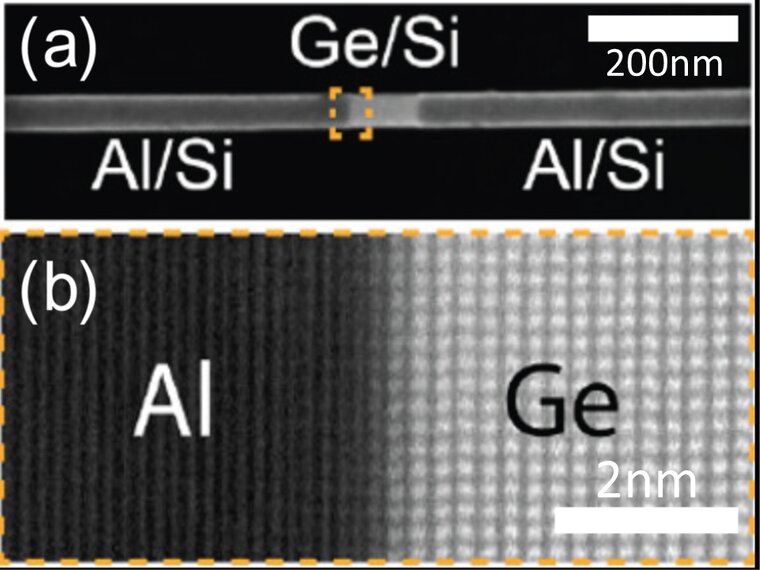
Collaborations: Alois Lugstein and Masiar Sistani, Institute of Solid-State Electronics at TU Wien, Vienna, Austria
Publications:
Highly transparent contacts to the 1D hole gas in ultra-scaled Ge/Si core/shell nanowires, M. Sistani, J. Delaforce, R. Kramer, N. Roch, M.A. Luong, M.I. den Hertog, E. Robin, J. Smoliner, J. Yao, C.M. Lieber, C. Naud, A. Lugstein, O. Buisson, ACS Nano 13, 12, 14145-14151 (2019).
Coulomb blockade in monolithic and monocrystalline Al-Ge-Al nanowire heterostructrures” by M. Sistani, J. Delaforce, K. Bharadwaj, M. Luong, J. Nacenta, N Roch, M. den Hertog, R. Kramer, O. Buisson, A. Lugstein and C. Naud, , Appl. Phys. Lett. 116, 013105 (2020).
Fundings: ANR QPSNanowires, COFUND Greque
The motion and the vibration of objects are phenomena we experience every day. But how does this translate at the quantum scale, when motion is governed by quantum mechanics? This question can now be investigated experimentally, with nano- and micro-objects being prepared in quantum states of motion. Acoustic/mechanical systems also play an essential role in quantum technologies, for instance as quantum interconnects or quantum sensors. In our team, we build and operate devices both for the development of such novel quantum technologies and for the investigation of fundamental aspects.
PhD students: Abel Hugot, Quentin Greffe.
Permanent staff: Jérémie Viennot, Julien Renard
In collaboration with Guillaume Jourdan (CEA Leti), Nicolas Roch and Franck Balestro.
Funding: ANR Q-MagMech, ANR STOUT
Controlling acoustic phonons at the quantum scale is opening up exciting new experimental avenues. In our lab, the key ingredient to achieve this control is the piezoelectric effect, which directly couples acoustic circuits with superconducting microwave circuits. Based on this technology, we develop hybrid circuits and we design them for specific aims: coupling to solid-state spins, control of non-linearities using Josephson junctions, etc. These experiments happen on chips fabricated in-house, measured at very low temperature (few mK) and microwave frequency (few GHz).
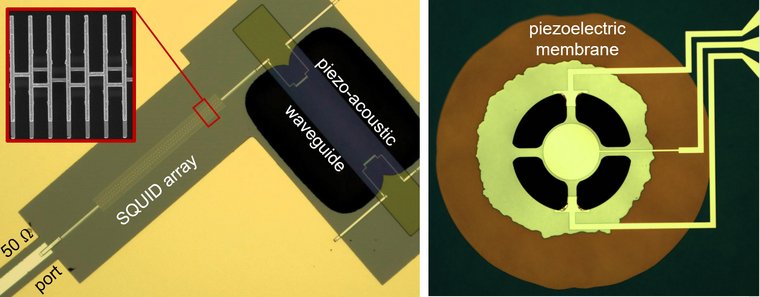
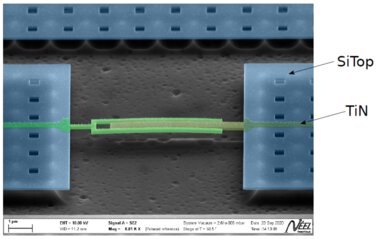
Superconducting qubits are one of the leading platform in experimental quantum information science. One roadblock to scale up these devices, which operate at microwave frequencies, is the lack of a coherent quantum channel to transport quantum information over long distances. At optical frequencies, such a channel is naturally available but optical light is not compatible with superconducting qubits. However, nano- and micro-mechanical oscillators can couple coherently both to microwave and optical photons. We develop such nanomechanical devices, with the aim to enable reversible and coherent transduction between microwave and optical photons.
An electronic spin in silicon 28 exhibits outstanding coherence properties and large-scale prospects for integration. Its main assets for scalability are immediate compatibility with CMOS technologies on one hand and effective sizes of spin qubits with all their quantum functionalities below the μm on the other hand.. Our objective is to explore the possibilities of scaling up and designing circuits with a large number of qubits made with CMOS technology. In the long term, we want to implement spin-based quantum digital computation in silicon and demonstrate quantum supremacy over classical computing for certain types of problems.
Key experiments have shown that the spin lifetime and coherence time can be adapted by appropriate molecular engineering indicating potentiality for quantum technologies. Moreover, molecular magnets provide access to state of-the-art qudits. These multi-level devices can be used to emulate processes involved in quantum spin manipulation. The use of qudits could also simplify the required circuits to fabricate the quantum computer itself. However, the future of molecular magnets for quantum information processing may be conditioned by our ability to propose scalable architectures and to speed-up our readout technique. The readout of nuclear spin states needs to be speed-up.. To achieve this acceleration of the readout cycle, different detection schemes are proposed. To this end, electron spin resonance technique and coupling to superconducting resonator are investigated.
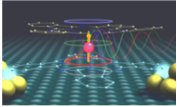 Key experiments have shown that the spin lifetime and coherence time can be adapted by appropriate molecular engineering indicating potentiality for quantum technologies. Moreover, molecular magnets provide access to state of-the-art qudits. These multi-level devices can be used to emulate processes involved in quantum spin manipulation. The use of qudits could also simplify the required circuits to fabricate the quantum computer itself. However, the future of molecular magnets for quantum information processing may be conditioned by our ability to propose scalable architectures and to speed-up our readout technique. The readout of nuclear spin states needs to be speed-up.. To achieve this acceleration of the readout cycle, different detection schemes are proposed. To this end, electron spin resonance technique and coupling to superconducting resonator are investigated.
Key experiments have shown that the spin lifetime and coherence time can be adapted by appropriate molecular engineering indicating potentiality for quantum technologies. Moreover, molecular magnets provide access to state of-the-art qudits. These multi-level devices can be used to emulate processes involved in quantum spin manipulation. The use of qudits could also simplify the required circuits to fabricate the quantum computer itself. However, the future of molecular magnets for quantum information processing may be conditioned by our ability to propose scalable architectures and to speed-up our readout technique. The readout of nuclear spin states needs to be speed-up.. To achieve this acceleration of the readout cycle, different detection schemes are proposed. To this end, electron spin resonance technique and coupling to superconducting resonator are investigated.
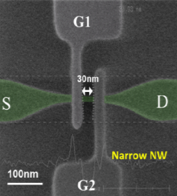 An electronic spin in silicon 28 exhibits outstanding coherence properties and large-scale prospects for integration. . Its main assets for scalability are immediate compatibility with CMOS technologies on one hand and effective sizes of spin qubits with all their quantum functionalities below the μm on the other hand.. Our objective is to explore the possibilities of scaling up and designing circuits with a large number of qubits made with CMOS technology. In the long term, we want to implement spin-based quantum digital computation in silicon and demonstrate quantum supremacy over classical computing for certain types of problems.
An electronic spin in silicon 28 exhibits outstanding coherence properties and large-scale prospects for integration. . Its main assets for scalability are immediate compatibility with CMOS technologies on one hand and effective sizes of spin qubits with all their quantum functionalities below the μm on the other hand.. Our objective is to explore the possibilities of scaling up and designing circuits with a large number of qubits made with CMOS technology. In the long term, we want to implement spin-based quantum digital computation in silicon and demonstrate quantum supremacy over classical computing for certain types of problems.
Coherent manipulation of single electrons in solid-state devices is attractive for quantum information purposes because they have a high potential for scalability. Depending on the system used, the charge or the spin may code binary qubit information. A particular appealing idea is to use a single flying electron itself as the conveyor of quantum information. Such electronic flying qubits allow performing quantum operations on qubits while they are being coherently transferred.
Information processing typically takes place in the nodes of the quantum network on locally controlled qubits, but quantum networking would require flying qubits to exchange information from one location to another. It is therefore of prime interest to develop ways of transferring information from one node to the other. The availability of flying qubits would enable the possibility to develop new non-local architectures for quantum computing with possibly cheaper hardware overhead than e.g. surface codes. The aim of our research is to establish a unique innovative platform for creating, manipulating and detecting single-electron wave packets in semiconductor quantum circuits and exploit them for quantum technologies.
This will include the development of (i) a picosecond on-demand coherent single-electron source and (ii) single-shot detection of propagating SEWP at the discrete charge level. With these technological breakthroughs we will be able to address (iii) quantum interferometry at the single-charge level. We will demonstrate the elementary building blocks that will be used for implementing a flying quantum bit. This will be combined with (iv) the development of a new software for predictive simulation and optimization of ultrafast quantum devices in collaboration with CEA Grenoble.
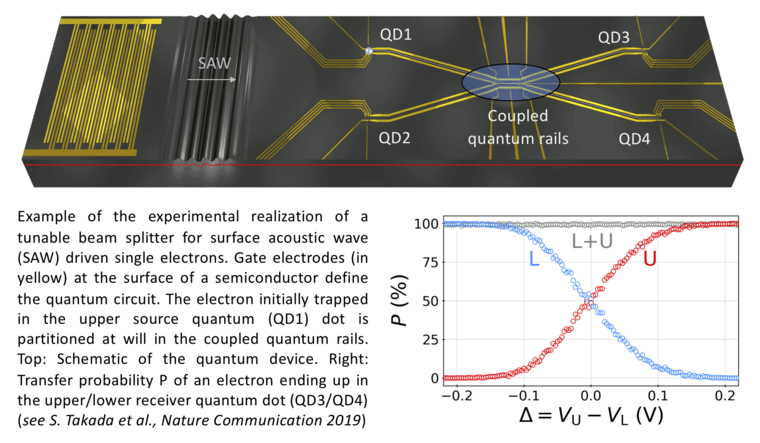
Further reading:
C. Bäuerle, D. C Glattli, T. Meunier, F. Portier, P. Roche, P. Roulleau, S. Takada, X. Waintal, Coherent control of single electrons : a review of current progress, Rep. Prog. Phys. 81 056503 (2018)
C. Bäuerle, T. Meunier and C. J. B. Ford, in Surface acoustic wave roadmap, Topical Review, J. Phys. D : Appl. Phys. 52 353001 (2019)
Collaboration and networking:
nanoelectronics group, Saclay (C. Glattli & P. Roulleau)
theory group, CEA Grenoble (X. Waintal & C. Groth)
Quantum Metrology Laboratory, AIST, Tsukuba, Japan (S. Takada & N. Kaneko)
RIKEN, Japan (M. Yamamoto)
Ruhr-Universität Bochum, Germany (A.D. Wieck)
Funding: ANR, H2020-FET-OPEN
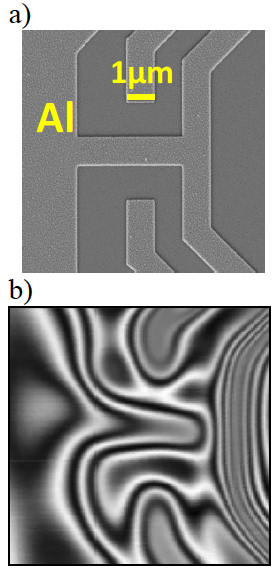
a) Test sample with Al electrostatic gates b) Scanning single electron transistor image of the test sample.
A number of phenomena in condensed matter physics lead to an inhomogeneous distribution of a physical quantity. For example, the flux distribution in superconductors or the electron density of states of a semiconductor. A direct visualisation of these inhomogeneous states is often the only way to reveal their existence. In a bulk measurement without spatial resolution these effects may stay hidden. Scanning probe microscopy allows the visualization of a physical quantity by scanning the surface of interest with a very small detector or probe. The images represent high resolution maps of the specific property probed by the detector. Today these techniques are a key tool in nanoscience and nanotechnology.
In this project, we use a scanning single electron transistor microscope at low temperatures (< 300 mK) and high magnetic fields (0–18 T). This microscope has been recently developed at Néel Institute and is now fully operational. The probe, a single electron transistor, allows very sensitive electric charge detection at the nanoscale. With such a scanning probe microscope most of the two-dimensional electron systems can be studied. Some prominent systems are edge channels in the quantum Hall regime, surface states of three dimensional topological insulators or inhomogeneous electronic states close to a metal-insulator phase transition.
Transport measurements can be done simultaneously in situ which allows a careful characterisation of the sample close to a phase transition. A direct visualisation of these states are key to the fundamental understanding of these phenomena.
In PTA and Nanofab clean rooms, both at Grenoble, we have access to state of the art clean-room facilities:
Our group is specialized in transport measurement at very low temperatures. This requires skills in cryogenics and specific wiring. Here are some examples of dilution fridges :
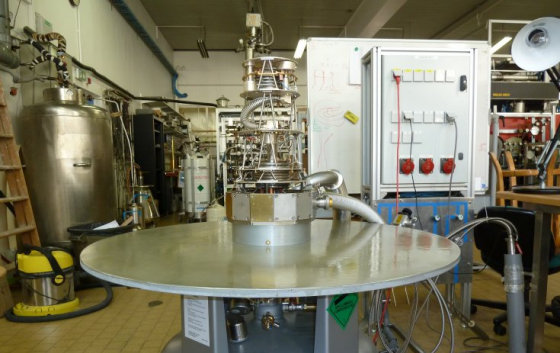 |
Dilution fridge called “SIONLUDI” This is an inverted fridge with large space for RF electronics and a base temperature close to 20 mK (cooling power: 250 µW). It is wired with 8 RF coax lines, 16 thermocoax wires and 27 manganine wires filtered with ECOSORB. It is equipped with a small, fast magnet that can generate a magnetic field up to 1 T. |
 |
Dilution fridge called “WODAN” This is a wet dilution fridge with large space for RF electronics and a base temperature close to 20 mK (cooling power: 1 mW). It is wired with 8 RF coax lines and 27 thermocoax wires. It is equipped with a two axis magnet 6 T/3 T |
In collaboration with the “pôle electronique” of the Néel Institute, we are developing low noise electronics (such as current amplifiers, low noise and highly stable DACs, voltage amplifiers) but also RF electronics (such as RF amplifiers, RF-DACs).
Position type: Master 2 internships and theses
Contact: Nicolas Roch - +33 4 56 38 71 77
The goal of this project is to co-integrate superconducting qubits and TWPA on the same chip. This will demonstrate the integration capabilities of our latest generation of TWPAs, which now include isolation features. From a fundamental physics perspective, this close integration of a superconducting qubit and an ultra-low noise amplifier will minimize loss between the two components and ensure the best possible signal-to-noise ratio. This setup will allow us to further our understanding of the quantum limits of superconducting qubit readout.
Position type: Master 2 internships and theses
Contact: Buisson Olivier - 0456387177
During the last decade, it has been demonstrated that superconducting Josephson quantum circuits constitute ideal blocks to realize quantum mechanical experiments and to build promising quantum bits for quantum information processing. These circuits appear as artificial atoms whose properties are fixed by electronics compounds (capacitance, inductance, tunnel barrier).
Recently, we implemented a new device, the transmon molecule [1], that shows very promising properties for high fidelity and Quantum Non-Demolition readout which overcomes the usual limitations [2,3]. In this project, we propose to demonstrate a superconducting multi-qubits plateform based on this original transmon molecule.
Position type: Master 2 internships and theses
Contact: Corentin DEPREZ - | Matias URDAMPILLETA -
When a quantum system performs a closed loop in a parameter space, its state undergoes a transformation that depends only on the geometry of the path followed and on the characteristics of the underlying Hilbert space. The path-dependent transformations, that are called either Wilczek-Zee holonomies or Berry phases depending on whether the quantum system considered is degenerate or not, have numerous consequences in condensed matter systems. While many experiments have demonstrated the existence of Berry phases in electronic systems, experimental studies of Wilczek-Zee holonomies remain scarce
During the intership, we will develop an experiment where single holes in germanium heterostructures are displaced in closed loops inside 2D quantum dot arrays at zero magnetic field.
Position type: Master 2 internships and theses
Contact: Christopher BAUERLE - | Hermann SELLIER -
Mesoscopic electronic colliders have provided direct evidence of exotic excitations such as fractional charges, levitons, and anyon statistics. Recently, we have taken an important step toward bridging the gap between few-particle collisions and many-body collective phenomena. The internship project builds on these results and aims to explore new regimes where exotic quantum correlations may emerge.
Position type: Master 2 internships and theses
Contact: Matias Urdampilleta - 04 76 88 79 34
The objective of the internship is to develop experiments using spin qubits in arrays of silicon MOS quantum dots. We have recently demonstrated the control of a 2×2 array and are willing to extend the size of this array as well as performing quantum operation within. The long-term objective (PhD) is to enforce quantum algorithm or simulation using a small array of CMOS spin qubits.
Therefore, the research involves participation in the design of quantum devices with our collaborators at CEA-LETI, development of control of the spin qubit array using state of the art DC and microwave electronic, data acquisition and analysis followed by publications and communication in conferences.
Position type: Post-doc
Contact: Matias Urdampilleta - +33 4 76 88 79 34
The position aims at developing experiments using spin qubits in arrays of semiconductor quantum dots. In particular, based on our recent result in small arrays, we aim at exploiting coherent control of spin qubit in larger arrays to perform quantum simulation or algorithm.
Therefore, the research involves participation in the design of quantum devices with our collaborators within the QLSI2 european consortium, optimization of spin readout at large scale, development of automatic control of qubit arrays using state of the art control electronic, data acquisition and analysis followed by publications and communication in conferences.
Position type: Post-doc
Contact: Matias Urdampilleta - +33 4 76 88 79 34
The position aims at developing low temperature experiments using magnonic systems and qubits. In particular, we aim at first investigating magnonic properties of YIG microstructures coupled to superconducting circuits at very low temperature. In a second time, the coupling between a magnon mode and a qubit will be explored. Based on this interaction, we aim at developing magnetometry protocols and characterize exotic magnetic structure at very low temperature.
Therefore, the research involves participation in the design of superconducting devices at Neel institute, very low temperature characterization of the magnonic system, qubit control, data acquisition and analysis followed by publications and communication in conferences.
Position type: Post-doc
Contact: Jérémie Viennot - | Julien Renard -
This project aims at developing a microwave-optical quantum interface to be used as a key element in future quantum technologies. Such an interface will permit long-distance transfer of microwave quantum information and enable optically-mediated entanglement of distant microwave qubits.
Person in charge: Cécile NAUD
Permanents
Students & Post-docs & CDD
Franck BALESTRO
Personnel Chercheur - UGA
Franck.Balestro [at] neel.cnrs.fr
Phone: 04 76 88 79 15
Office: K-206B
Christopher BAUERLE
Personnel Chercheur - CNRS
Christopher.Bauerle [at] neel.cnrs.fr
Phone: 04 76 88 78 43
Office: M-113
Edgar BONET-OROZCO
Personnel Chercheur - CNRS
edgar.bonet [at] neel.cnrs.fr
Phone: 04 76 88 10 96
Office: K-206
Olivier BUISSON
Personnel Chercheur - CNRS
Olivier.Buisson [at] neel.cnrs.fr
Phone: 04 56 38 71 77
Office: Z-221
Quentin FICHEUX
Personnel Chercheur - CNRS
quentin.ficheux [at] neel.cnrs.fr
Office: Z-220
Wiebke HASCH
Personnel Chercheur - UGA
wiebke.hasch [at] neel.cnrs.fr
Phone: 04 56 38 70 17
Office: Z-220
Laurent LEVY
Personnel Chercheur - UGA
laurent.levy [at] neel.cnrs.fr
Phone: 04 76 88 11 22
Office: D-215
Cécile NAUD
Personnel Chercheur - CNRS
Cecile.Naud [at] neel.cnrs.fr
Phone: 04 56 38 70 17
Office: Z-220
Nicolas ROCH
Personnel Chercheur - CNRS
Nicolas.Roch [at] neel.cnrs.fr
Phone: 04 56 38 71 77
Office: Z-221
Matias URDAMPILLETA
Personnel Chercheur - CNRS
matias.urdampilleta [at] neel.cnrs.fr
Phone: 04 76 88 79 34
Office: M-107
Jérémie VIENNOT
Personnel Chercheur - CNRS
jeremie.viennot [at] neel.cnrs.fr
Phone: 04 76 88 79 05
Office: D-212
Uzer AHMAD
Personnel Chercheur - CNRS
uzer.ahmad [at] neel.cnrs.fr
Referent: Christopher BAUERLE
Mattéo ALUFFI
Personnel Chercheur - UGA
matteo.aluffi [at] neel.cnrs.fr
Referent: Christopher BAUERLE
Wael ARDATI
Personnel Chercheur - CNRS
wael.ardati [at] neel.cnrs.fr
Phone: 04 76 88 74 73
Office: D-419
Referent: Nicolas ROCH
Ali BADRELDIN-MOSTAF
Personnel Chercheur - UGA
ali.badreldin-mostaf [at] neel.cnrs.fr
Phone: 04 76 88 79 47
Office: M-104
Referent: Matias URDAMPILLETA
Quentin BENICHOU
Personnel Chercheur - CNRS
quentin.benichou [at] neel.cnrs.fr
Referent: Christopher BAUERLE
Carson-Scott BRAME
Personnel Chercheur - CNRS
carson-scott.brame [at] neel.cnrs.fr
Referent: Nicolas ROCH
Anas CHADLI
Personnel Chercheur - UGA
anas.chadli [at] neel.cnrs.fr
Phone: 04 76 88 74 73
Office: D-419
Referent: Nicolas ROCH
Deepanjan DAS
Personnel Chercheur - CNRS
deepanjan.das [at] neel.cnrs.fr
Referent: Nicolas ROCH
Corentin DEPREZ
Personnel Chercheur - CNRS
corentin.deprez [at] neel.cnrs.fr
Referent: Matias URDAMPILLETA
Francesca DESPOSITO
Personnel Chercheur - UGA
francesca.desposito [at] neel.cnrs.fr
Referent: Olivier BUISSON
Jean-Baptiste FILIPPINI
Personnel Chercheur - CNRS
jean-baptiste.filippini [at] neel.cnrs.fr
Phone: 04 76 88 79 47
Office: M-104
Referent: Franck BALESTRO
Clément GEFFROY
Personnel Chercheur - CNRS
clement.geffroy [at] neel.cnrs.fr
Phone: 04 76 88 12 29
Office: M-112
Referent: Christopher BAUERLE
Maxime GONTEL
Personnel Technique - CNRS
maxime.gontel [at] neel.cnrs.fr
Referent: Matias URDAMPILLETA
Quentin GREFFE
Personnel Chercheur - CNRS
quentin.greffe [at] neel.cnrs.fr
Referent: Jérémie VIENNOT
Guillermo HAAS
Personnel Chercheur - CNRS
guillermo.haas [at] neel.cnrs.fr
Phone: 04 76 88 79 47
Office: M-104
Referent: Matias URDAMPILLETA
Mathieu KALBFEIS-DIT-DARNAS
Personnel Chercheur - CNRS
mathieu.kalbfeis-dit-darnas [at] neel.cnrs.fr
Office: V-109
Referent: Franck BALESTRO
Shelender KUMAR
Personnel Chercheur - CNRS
shelender.kumar [at] neel.cnrs.fr
Phone: 04 56 38 70 29
Office: Z-223
Referent: Nicolas ROCH
Supriya MANDAL
Personnel Chercheur - CNRS
supriya.mandal [at] neel.cnrs.fr
Referent: Quentin FICHEUX
Lucas MAZZELLA
Personnel Chercheur - UGA
lucas.mazzella [at] neel.cnrs.fr
Referent: Christopher BAUERLE
Lucas MEDEIROS-RUELA
Personnel Chercheur - CNRS
lucas.ruela [at] neel.cnrs.fr
Phone: 04 56 38 70 12
Office: D-215
Referent: Olivier BUISSON
Cindy MORENO-SARRIA
Personnel Chercheur - UGA
cindy.moreno-sarria [at] neel.cnrs.fr
Phone: 04 76 88 12 29
Office: M-112
Referent: Christopher BAUERLE
Sébastien MORETTI
Personnel Chercheur - SILENT WAVES
sebastien.moretti [at] neel.cnrs.fr
Phone: 04 76 88 71 78
Office: Z-218
Referent: Nicolas ROCH
Dorian NICOLAS
Personnel Chercheur - CNRS
dorian.nicolas [at] neel.cnrs.fr
Referent: Quentin FICHEUX
Marceau NOUVELLON
Personnel Chercheur - CNRS
marceau.nouvellon [at] neel.cnrs.fr
Referent: Christopher BAUERLE
Mohamed Seddik OUACEL
Personnel Chercheur - CNRS
mohamed-seddik.ouacel [at] neel.cnrs.fr
Office: M-105
Referent: Christopher BAUERLE
Ujjawal SINGHAL
Personnel Chercheur - CNRS
ujjawal.singhal [at] neel.cnrs.fr
Referent: Nicolas ROCH
Jean-Samuel TETTEKPOE
Personnel Chercheur - Ministère des Armées
jean-samuel.tettekpoe [at] neel.cnrs.fr
Phone: 04 76 88 70 61
Office: D-318
Referent: Quentin FICHEUX
Maxime TOMASIAN
Personnel Chercheur - UGA
maxime.tomasian [at] neel.cnrs.fr
Phone: 04 76 88 74 65
Office: D-412
Referent: Jérémie VIENNOT
Alba TORRAS
Personnel Chercheur - CNRS
alba.torras [at] neel.cnrs.fr
Referent: Nicolas ROCH
Thomas VASSELON
Personnel Chercheur - CNRS
thomas.vasselon [at] neel.cnrs.fr
Referent: Christopher BAUERLE
Baptiste JADOT
Personnel Chercheur - CEA
baptiste.jadot [at] neel.cnrs.fr
Phone: 04 76 88 90 44
Office: V-105
Referent: Tristan MEUNIER
Jean-Baptiste VIGNERON
Personnel Chercheur - UGA
jean-baptiste.vigneron [at] neel.cnrs.fr
Referent: Christopher BAUERLE
Wolfgang WERNSDORFER
Personnel Chercheur - Institut de Physique du KIT
Wolfgang.Wernsdorfer [at] neel.cnrs.fr
Phone: 04 76 88 79 09
Office: D-113
Referent: Franck BALESTRO
